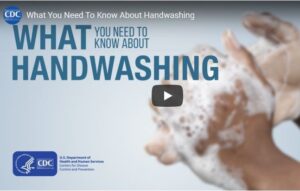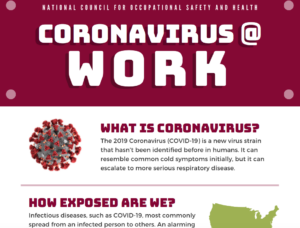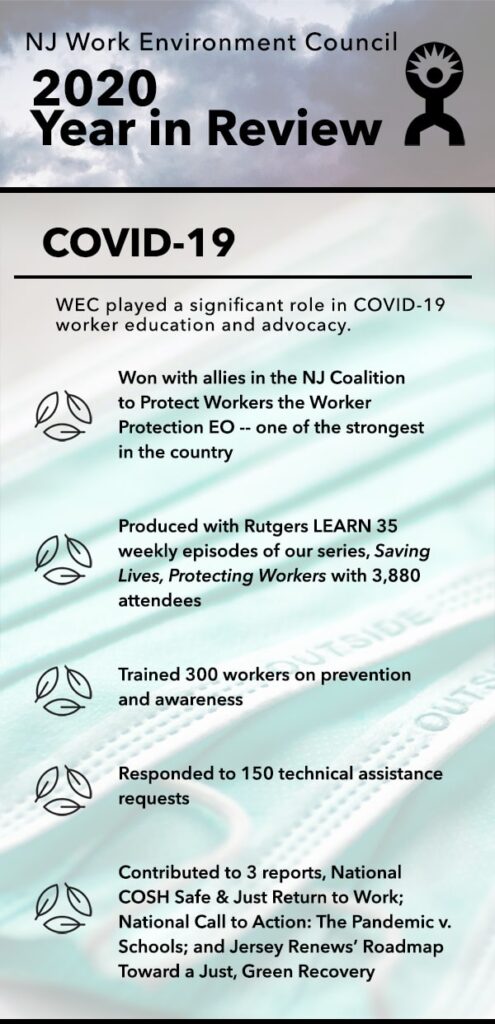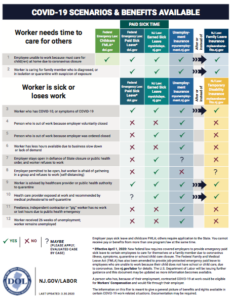COVID-19 Resources
What is COVID-19?
The most recent coronavirus, COVID-19, is a new strain of virus that hasn’t been identified before in humans. The COVID-19 virus is a respiratory pathogen that is highly contagious, and it is far more lethal than the flu virus.
Some symptoms of coronavirus include – fever, cough, body aches and tiredness and they can worsen and cause pneumonia, fluid in the lungs that leads to shortness of breath. The COVID-19 illness is more severe than the flu, and the chance of dying from it is greater than the seasonal flu, estimates up to 30x greater risk of death. COVID-19 has been able to spread from person to person very easily and requires an immediate response to protect workers and the general public.
The best way to prevent illness is to avoid being exposed to this virus. Some recent studies have suggested that COVID-19 may be spread by people who are not showing symptoms. The virus is thought to spread mainly from person-to-person, between people who are in close contact with one another (within about 6 feet), through respiratory droplets produced when an infected person coughs, sneezes or talks because these droplets can land in the mouths or noses of people who are nearby or possibly be inhaled into the lungs.
Protect Yourself!
Steps to Take to Protect Yourself
Below are some steps you can take to protect yourself at work or in your daily life. This is not a comprehensive list. It is important to note, as more is learned about COVID-19, the Center for Disease Control and Prevention (CDC) continues to update their guidance on how to protect yourself. For the most recent updates, visit the CDC website.
- Wear a mask to protect yourself and others and stop the spread of COVID-19. Wear your mask over your nose and mouth and secure it under your chin. Fit the mask snugly against the sides of your face, slipping the loops over your ears or tying the strings behind your head.
- Stay at least 6 feet (about 2 arm lengths) from others who don’t live with you.
- Avoid crowds. The more people you are in contact with, the more likely you are to be exposed to COVID-19.
- Avoid poorly ventilated spaces.
- Wash your hands often. If soap and water are not readily available, use a hand sanitizer that contains at least 60% alcohol.
- Monitor health daily.
- Get Vaccinated to Protect Against COVID-19
- Clean and disinfect objects and surfaces you touch often. Use cleaning products as directed.
Employers should follow the MOST protective guidance and standards issued by state or federal agencies. If guidance contradicts each other, the MOST protective should be implemented.
COVID-19 Weekly Updates: Saving Lives, Protecting Workers
In this weekly series, we will hear from and talk with public health experts, government officials, medical personnel, front-line workers and worker representatives about the latest developments in the fight against COVID-19. The series is sponsored by WEC, Rutgers Learn and Jersey Renews and airs on Tuesday @ 12pm. Want to receive weekly series emails, sign up here.
Past Webinar Summaries
November 17: NJ Executive Order 192 – What are the New COVID-19 Protections for Workers?
This week’s webinar focused on Executive Order (EO) 192 which Governor Murphy signed on October 28 and went into effect on November 5. The EO, one of the strongest in the country, mandates a series of COVID-19 protections for workers in both public and private sector employment settings. There were more than 97 people who attended this webinar.
This week we were joined by:
Lou Kimmel, Executive Director of New Labor who spoke to the success of EO 192 after a six-month campaign by the Protect NJ Workers Coalition. The EO expands worker protections by requiring employers to establish […]
November 10: A COVID Health & Safety Conversation with Peg Seminario
This week, we were joined by Peg Seminario, Former Director of Occupational Safety and Health for the AFL-CIO from 1990 until her retirement in 2019.
Peg talked about the failure of federal OSHA to protect workers from not issuing an emergency infectious disease standard to not requiring employers to report workplace COVID cases and the general lack of inaction in the early days. She also noted that neither the federal or state governments have established data collection systems to track COVID cases in the workplace.
Recommendations she made for OSHA included issuing an infectious disease emergency standard, using the Illness and Injury […]
October 27: The Importance of Reporting: Filing an Effective Complaint
Today Ellie Barbarash, Health and Safety Coordinator for Health Professionals and Allied Employees, drew upon her experience and long track record of filing successful OSHA complaints.
With changing CDC COVID guidance and no OSHA standard for infectious disease, Ellie identified five health and safety areas relevant to COVID exposure including respiratory protection, PPE, hazard communication, recordkeeping, and, depending on the circumstances, bloodborne pathogens. Ellie talked us through collecting worker exposure stories, collecting information, identifying witnesses, composing and submitting a complaint.
Ellie acknowledged that an effective complaint is labor-intensive. However, doing your homework and filing a detailed complaint does significantly increase the […]
October 20: How Prepared are We for a Second Wave? Lessons Learned and Challenges Still Ahead in Healthcare
This week we were joined by Debbie White, RN and President of HPAE, who recapped the horror, confusion, and trauma of the first wave of COVID for patients and healthcare workers, while outlining how we can best be prepared to avoid the same issues during a second wave of COVID.
She emphasized the importance of worker voices in pandemic preparedness and how labor unions can lead in fighting to improve health and safety protocols to protect workers and patients. She also elaborated on bills the New Jersey legislature has passed, because of strong organizing from workers, including:
- Workers Compensation – […]
October 13: Is Covid Cleaning Making you Sick? Disinfectants may be effective, but are they safe?
This week we took a deeper dive into the use of hazardous chemicals in the workplace, specifically as they are used to combat the spread of COVID19. A rush to prevent viral spread has in some cases meant the use of unnecessary and even dangerous products that may harm our health. Today’s panelists discussed the OSHA Hazard Communication Standard revised in 2012, Safety Data Sheets (SDSs) (formerly MSDSs or Material Safety Data Sheets), exposure routes into the body, and safer products and practices when using chemicals in the workplace.
We heard from WEC’s […]
The COVID-19 webinar series is sponsored by



Benefits for Workers
NJ Department of Labor and Workforce Development Resources
- What NJ Workers Need to Know about the Families First Coronavirus Response Act Factsheet
- NJ Division of Unemployment: https://myunemployment.nj.gov/
- Guidance for Self-Employed Individuals Filing a Pandemic Unemployment Assistance Claim and FAQs
- NJ Family leave Insurance: https://myleavebenefits.nj.gov/labor/myleavebenefits/worker/fli/index.shtml
- NJ Earned Paid Sick Leave: https://www.nj.gov/labor/worker-protections/earnedsick/law.shtml
- NJ Temporary Disability Insurance: https://myleavebenefits.nj.gov/labor/myleavebenefits/worker/tdi/index.shtml
Federal Paid Sick Leave and CARES act expansions and stimulus
- US Department of Labor: Families First Coronavirus Response Act: Employee Paid Leave Rights



